1998 PONTIAC BONNEVILLE brakes
[x] Cancel search: brakesPage 82 of 395
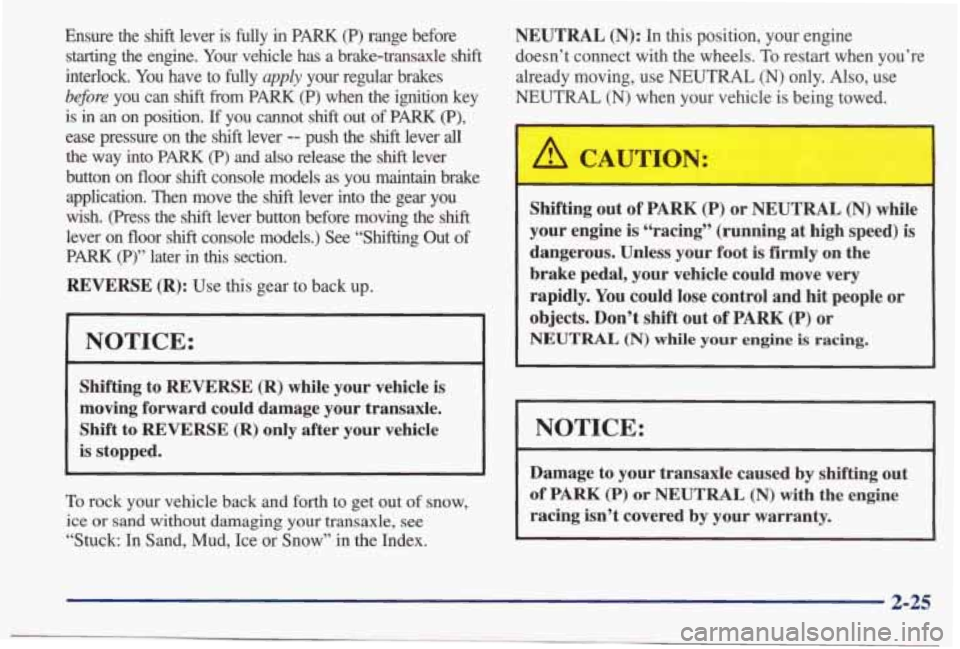
Ensure the shift lever is fully in PARK (P) range before
starting the engine. Your vehicle has a brake-transaxle shift
interlock. You have to fully apply your regular brakes
b#ore you can shift from PARK (P) when the ignition key
is
in an on position. If you cannot shift out of PARK (P),
ease pressure on the shift lever -- push the shift lever all
the way into PARK (P) and also release the shift lever
button on floor
shift console models as you maintain brake
application. Then move the
shift lever into the gear you
wish. (Press the
shift lever button before moving the shift
lever on floor shift console models.) See “Shifting Out of
PARK (P)” later in this section.
REVERSE (R): Use this gear to back up.
NOTICE:
Shifting to REVERSE (R) while your vehicle is
moving forward could damage your transaxle.
Shift to
REVERSE (R) only after your vehicle
is stopped.
To rock your vehicle back and forth to get out of snow,
ice or sand without damaging your transaxle, see
“Stuck: In Sand, Mud, Ice or Snow” in the Index.
NEUTRAL (N): In this position, your engine
doesn’t connect with the wheels. To restart when you’re
already moving, use NEUTRAL
(N) only. Also, use
NEUTRAL (N) when your vehicle is being towed.
A CAUTION:
Shifting out of PARK (P) or NEUTRAL (N) while
your engine is “racing” (running at
high speed) is
dangerous. Unless your foot is
firmly on the
brake pedal, your vehicle could move very
rapidly. You
could lose control and hit people or
objects. Don’t shift out of PARK (P) or
NEUTRAL (N) while your engine is racing.
NOTICE:
Damage to your transaxle caused by shifting out
of PARK (P) or NEUTRAL (N) with the engine
racing isn’t covered
by your warranty.
2-25
Page 83 of 395
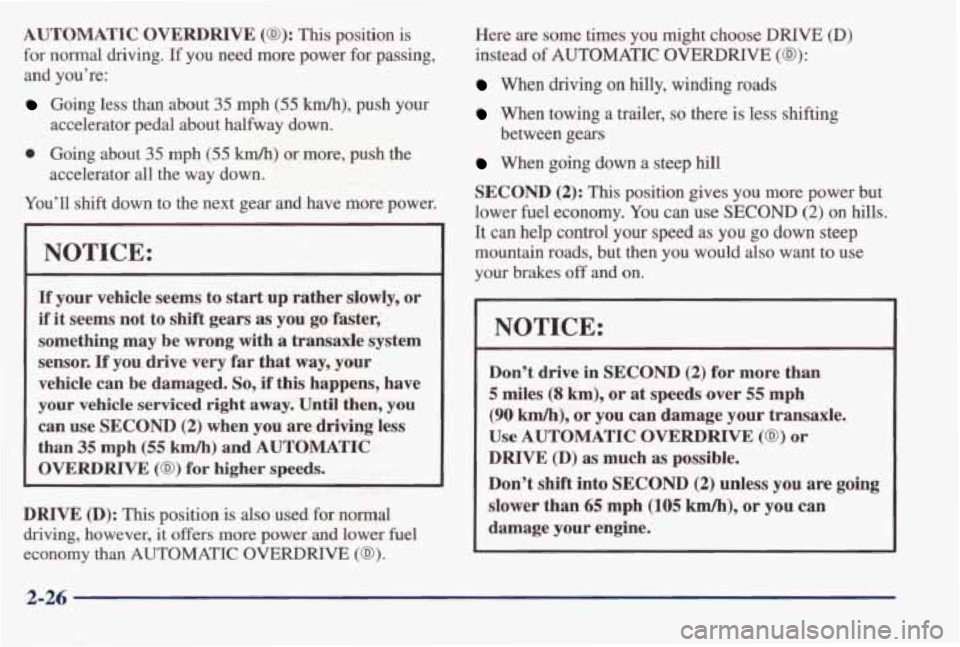
AUTOMATIC OVERDRIVE (@I): This position is
for normal driving.
If you need more power for passing,
and you’re:
Going less than about 35 mph (55 km/h), push your
0 Going about 35 mph (55 km/h) or more, push the
You’ll shift down to the next gear and have more power.
accelerator pedal about halfway down.
accelerator
all the way down.
NOTICE:
If your vehicle seems to start up rather slowly, or
if it seems not to shift gears as you go faster,
something may be wrong with a transaxle system
sensor.
If you drive very far that way, your
vehicle can be damaged.
So, if this happens, have
your
vehicle serviced right away. Until then, you
can use
SECOND (2) when you are driving less
than 35 mph (55 km/h) and AUTOMATIC
OVERDRIVE (0) for higher speeds.
DRIVE @): This position is also used for normal
driving, however, it offers more power and lower fuel
economy than AUTOMATIC OVERDRIVE (@).
Here are some times you might choose DRIVE (D)
instead of AUTOMATIC OVERDRIVE (0):
When driving on hilly, winding roads
When towing a trailer, so there is less shifting
When going down a steep hill
SECOND (2): This position gives you more power but
lower fuel economy.
You can use SECOND (2) on hills.
It can help control your speed as you go down steep
mountain roads, but then
you would also want to use
your brakes
off and on.
between gears
NOTICE:
Don’t drive in SECOND (2) for more than
5 miles (8 km), or at speeds over 55 mph
(90 M), or you can damage your transaxle.
Use AUTOMATIC OVERDRIVE (0) or
DRIVE @) as much as possible.
Don’t shif’t into SECOND (2) unless you are going
slower than 65 mph (105 km/h), or you can
damage your engine.
2-26
Page 84 of 395
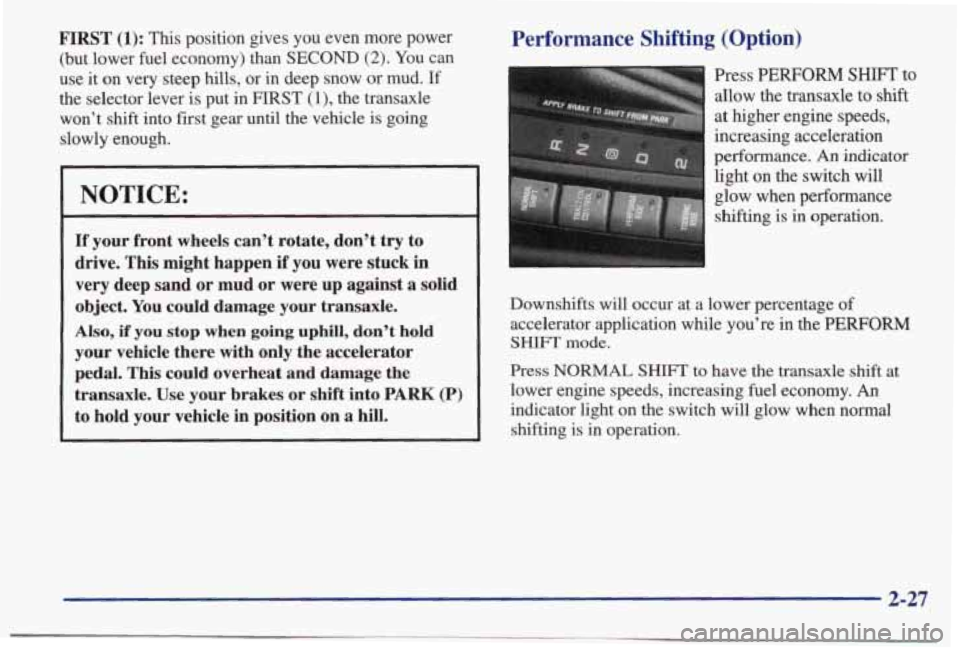
FIRST (1): This position gives you even more power
(but lower fuel economy) than
SECOND (2). You can
use it on very steep hills, or in deep snow or mud.
If
the selector lever is put in FIRST (l), the transaxle
won't
shift into first gear until the vehicle is going
slowly enough.
NOTICE:
If your front wheels can't rotate, don't try to
drive. This might happen
if you were stuck in
very deep sand or mud or were up against a solid
object. You could damage your transaxle.
Also, if you stop when going uphill, don't hold
your vehicle there with only the accelerator
pedal. This could overheat and damage the
transaxle. Use your brakes or shift into
PARK (P)
to hold your vehicle in position on a hill.
Performance Shifting (Option)
Press PERFORM SHIFI' to
allow the transaxle to shift
at higher engine speeds,
increasing acceleration
performance.
An indicator
light on the switch will
glow when performance
shifting is
in operation.
Downshifts will occur at a lower percentage
of
accelerator application while you're in the PERFORM
SHIFT mode.
Press NORMAL SHIFT to have the transaxle shift at
lower engine speeds, increasing fuel economy.
An
indicator light on the switch will glow when normal
shifting is in operation.
2-27
Page 86 of 395
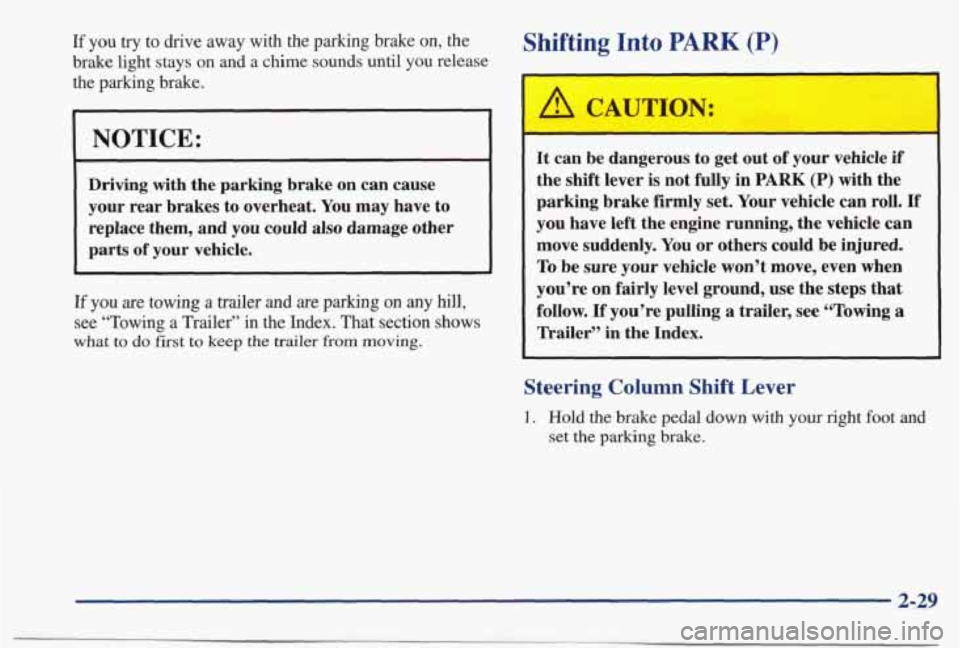
If you try to drive away with the parking brake on, the
brake light stays on and a chime sounds until you release
the parking brake.
NOTICE:
Driving with the parking brake on can cause
your rear brakes to overheat. You may have to
replace them, and you could also damage other
parts of your vehicle.
3
If you are towing a trailer and are parking on any hill,
see “Towing a Trailer” in the Index. That section shows
what to do first to keep the trailer from moving.
Shifting Into PARK (P)
It can be dangerous to get out of your vehicle if
the shift lever is not fully in PARK (P) with the
parking brake firmly set. Your vehicle
can roll. If
you have left the engine running, the vehicle can
move suddenly. You or others could be injured.
To be sure your vehicle won’t move, even when
you’re on fairly level ground, use the
steps that
follow.
If you’re pulling a trailer, see “Towing a
Trailer” in the Index.
Steering Column Shift Lever
1. Hold the brake pedal down with your right foot and
set
the parking brake.
2-29
Page 97 of 395
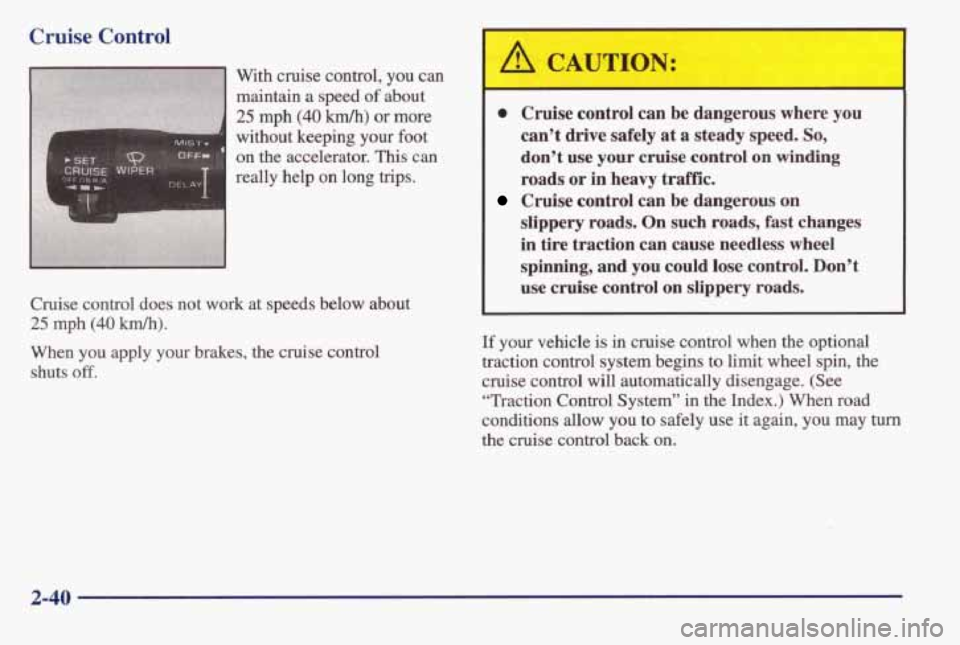
Cruise Control
on the accelerator. This can
really help
on long trips.
Cruise control
does not work at speeds below about
25 mph (40 km/h).
When you apply your brakes, the cruise control
shuts off.
I A CAUTION:
0 Cruise control can be dangerous where you
can’t drive safely at a steady speed.
So,
don’t use your cruise control on winding
roads or in heavy traffic.
slippery roads.
On such roads, fast changes
in tire traction can cause needless wheel
spinning,
and you could lose control. Don’t
use cruise control on slippery roads.
Cruise control can be dangerous on
If your vehicle is in cruise control when the optional
traction control system begins to limit wheel spin, the
cruise control will automatically disengage. (See “Traction Control System” in the Index.) When road
conditions allow
you to safely use it again, you may turn
the cruise control back on.
2-40
Page 123 of 395
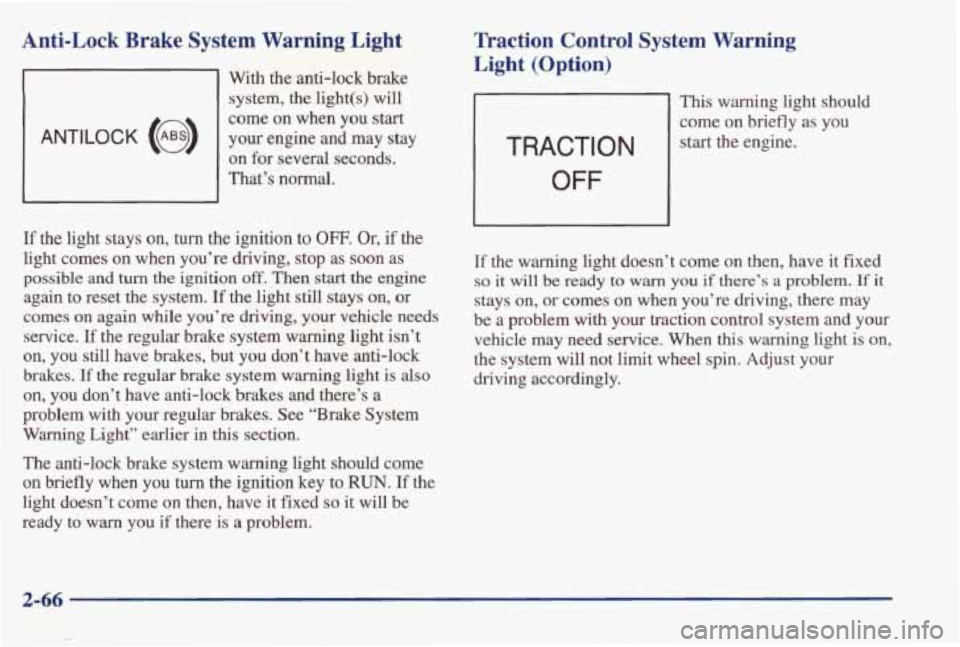
Anti-Lock Brake System Warning Light
ANTILOCK (@)
With the anti-lock brake system,
the light(s) will
come on when
you start
your engine and may stay
on for several seconds.
That’s normal.
llraction Control System Warning
Light (Option)
TRACTION
OFF
This warning light should
come on briefly as you
start the engine.
If the light stays on, turn the ignition to OFF. Or, if the
light comes on when you’re driving, stop as soon as
possible
and turn the ignition off. Then start the engine
again to reset the system.
If the light still stays on, or
comes on again while you’re driving, your vehicle needs
service. If the regular brake system warning light isn’t
on, you still have brakes, but you don’t have anti-lock
brakes.
If the regular brake system warning light is also
on, you don’t have anti-lock brakes and there’s a
problem with your regular brakes. See “Brake System
Warning Light” earlier in
this section.
If the warning light doesn’t come on then, have it fixed
so it will be ready to warn you if there’s a problem. If it
stays on, or comes on when you’re driving, there may
be a problem with your traction control system and your
vehicle may need service. When this warning light is on,
the system will not limit wheel spin. Adjust your
driving accordingly.
The anti-lock brake system warning light should come
on briefly when you turn the ignition key to RUN. If the
light doesn’t come on then, have it fixed
so it will be
ready to
warn you if there is a problem.
Page 124 of 395
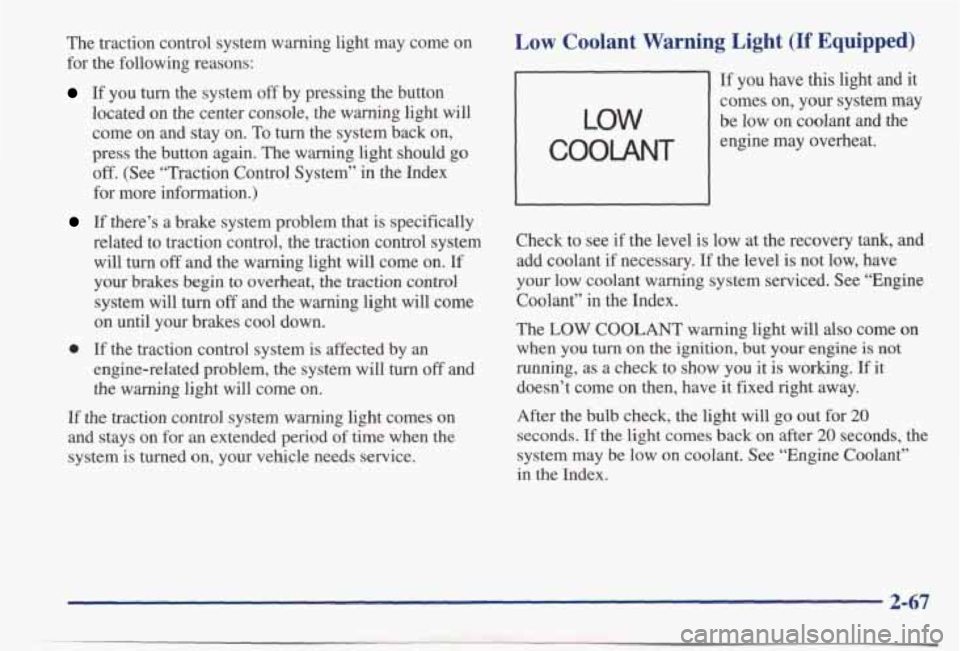
The traction control system warning light may come on
for the following reasons:
If you turn the system off by pressing the button
located on the center console, the warning light will come on and stay on.
To turn the system back on,
press the button again.
The warning light should go
off. (See “Traction Control System” in the Index
for more information.)
Low Coolant Warning Light (If Equipped)
LOW
COOLANT
’ If you have this light and it
comes on, your system may
be low on coolant and the
engine may overheat.
If there’s a brake system problem that is specifically
related to traction control, the traction control system will turn
off and the warning light will come on. If
your brakes begin to overheat, the traction control
system will
turn off and the warning light will come
on until your brakes cool down.
engine-related problem, the system will
turn off and
the warning light will come on.
0 If the traction control system is affected by an
If the traction control system warning light comes on
and stays on for
an extended period of time when the
system is turned on, your vehicle needs service. Check to see if
the level is low at the recovery tank, and
add coolant
if necessary. If the level is not low, have
your low coolant warning system serviced. See “Engine
Coolant” in the Index.
The
LOW COOLANT warning light will also come on
when you
turn on the ignition, but your engine is not
running, as a check to show you it is working. If it
doesn’t come on then, have it fixed right away.
After the bulb check, the light will
go out for 20
seconds. If the light comes back on after 20 seconds, the
system may be low on coolant. See “Engine Coolant”
in the Index.
2-67
Page 179 of 395
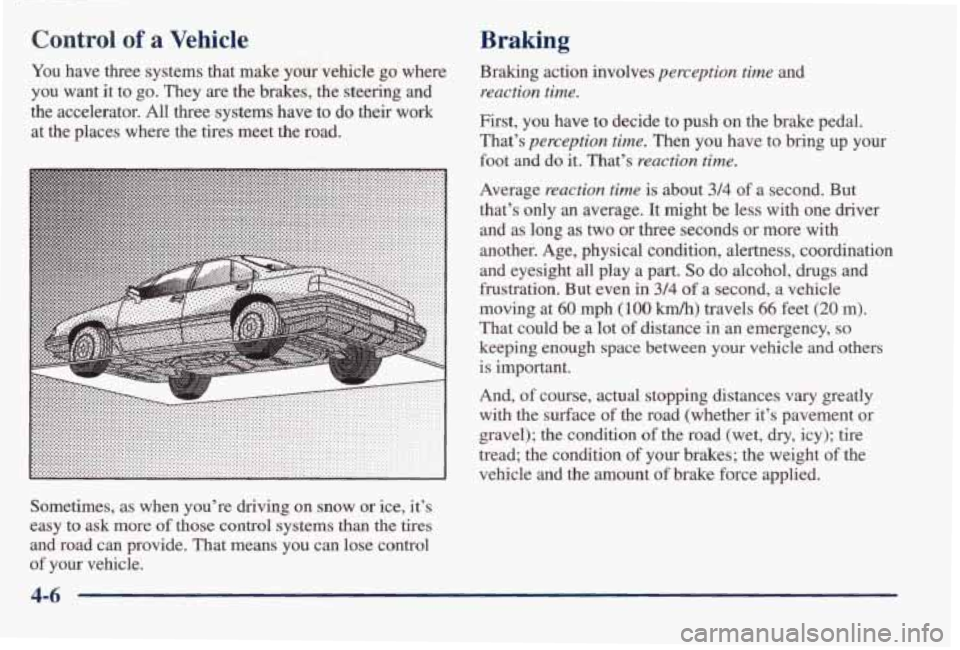
Control of a Vehicle
You have three systems that make your vehicle go where
you want
it to go. They are the brakes, the steering and
the accelerator.
All three systems have to do their work
at the places where the tires meet the road.
Sometimes, as when you’re driving on snow or ice, it’s
easy to ask more
of those control systems than the tires
and road can provide. That means you can lose control
of your vehicle.
Braking
Braking action involves perception time and
reaction time.
First, you have to decide to push on the brake pedal.
That’s
perception time. Then you have to bring up your
foot and do
it. That’s reaction time.
Average reaction time is about 3/4 of a second. But
that’s
only an average. It might be less with one driver
and as long as
two or three seconds or more with
another. Age, physical condition, alertness, coordination
and eyesight all play a part.
So do alcohol, drugs and
frustration. But even in
3/4 of a second, a vehicle
moving at
60 mph (100 kmk) travels 66 feet (20 m).
That could be a lot of distance in an emergency, so
keeping enough space between your vehicle and others
is important.
And, of course, actual stopping distances vary greatly
with the surface of the road (whether it’s pavement
or
gravel); the condition of the road (wet, dry, icy); tire
tread; the condition
of your brakes; the weight of the
vehicle and the amount
of brake force applied.
4-6